REVISITING DISNEY: THE BLACK CAULDRON
Welcome to Revisiting Disney! Today, we’re looking at a film that has always flown a bit under the radar, The Black Cauldron! Like last time, I have labeled each category so if you want to skip to the parts that interest you most, feel free. And, of course, if you have any thoughts, burning or otherwise, please share in the comments!
BACKGROUND
The Black Cauldron is a strange case in that it was made by Disney during a time of extreme change. Bob Thomas calls it a time of “corporate upheaval,” with Michael Eisner assuming the role of President, Jeffery Katzenberg becoming the new Studio Chairman, and Roy Disney, Walt’s nephew, becoming head of the animation department (Thomas 1992:114).
Released on July 24th, 1985, The Black Cauldron took seven years to develop. It was also cut and went through several revisions to avoid a PG-13 or R rating; between 10 and 15 minutes of animation were removed. Even so, it was the first of Disney’s animated features to warrant a PG rating.
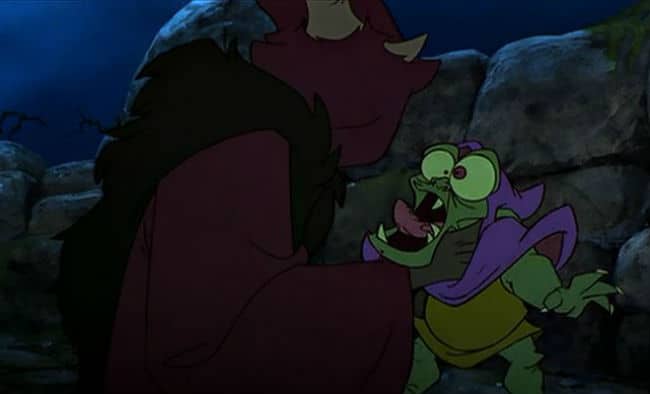
Photo: Disney
Although it is a film that the Disney Studio seems to be trying to bury (it was years before it received a video release), whatever else you say about it, The Black Cauldron was, in a lot of ways, a groundbreaking film.
MUSIC
Something that makes The Black Cauldron unique is that it has no songs at all. The other films without songs sung by characters, like Bambi, had a background chorus, but The Black Cauldron had no songs with words. The score, however, was masterfully crafted by Elmer Bernstein.
Bernstein composed the incidental music for the 1960 production of Peter Pan, as well as composing the music for Ghostbusters, The Magnificent Seven, Thoroughly Modern Millie (which he won an Oscar for), The Man with the Golden Arm, The Great Escape, and Cecil B. DeMille’s The Ten Commandments.
Born in California in 1922, he attended the Walden School and New York University. He also served in the Army Air Corp during World War II, during which he arranged music for Glenn Miller and the Army Air Force Band. He passed away in 2004 in New York City.
His scores are epic, and this one is no exception. His work, particularly those composed in the ’80’s, can often take on an otherworldly quality. His IMDB page credits this to his use of the Ondes Martenot, which, near as I can tell from pictures, is an early electric keyboard developed in France in the late 1920s.
This particular score is beautiful and has always been one of my favorites. It’s soft, lilting and fun in some places while knowing exactly when to turn dark and foreboding. It fits the tone of the movie, and in a lot of ways makes it more epic. When you have the guy who composed for The Ten Commandments, how can it not be somewhat epic in places?
ANIMATION
With the last of the Nine Old Men having retired, the process was left in the hands of the new generation, a transition that animator Andreas Deja called “a stormy period of change,” while another member of the young generation, John Musker thought, the film was “stodgy in many ways,” and that “a lot of the younger people believed it was misguided” (Thomas 1992: 113).
I’ve already mentioned Eisner, Katzenberg, Roy Disney, Deja, and Musker, but there are some other names I want to throw out there. Other new people that will be important later include Peter Schneider, Glen Keane, and Ron Clements. More will come up later, but for now, here are the new kids.
Tim Burton, who had worked on conceptual art for The Black Cauldron would leave after the film’s release because he felt that “the company was really at odds with itself…there was one foot in the past and a foot in the future and no firm footing in either,” (Thomas 1992: 113).
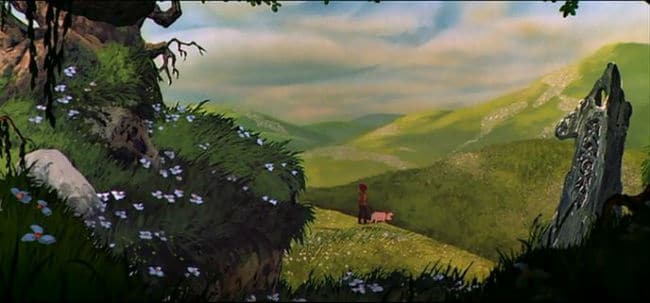
Photo: Disney
Bob Thomas writes that The Black Cauldron “was anticipated as a giant step forward for Disney animation…(and) promised to offer bold new art by Disney’s young generation” (Thomas 1992: 112). Frankly, looking at the film from a purely artistic point of view, it was and did.
Like Sleeping Beauty, The Black Cauldron was shot using the 70 mm Technirama widescreen system. It would be the last movie to be filmed this way, probably owing in part to the expense. The film also used a 70mm 6-track Dolby stereo sound and was the first of Disney’s animated films to do so.
The Black Cauldron was also the first Disney movie to make use of computer technology in the film. This is a big deal, especially considering the impact that the computer would have on the field. Honestly, this is a just a great looking movie.
The film also used the multi-plane cameras that had been used in the Golden Age (first and second) for some shots. Although the new technologies being developed made this technology less than critical, I personally love the use of both.
During the production of The Black Cauldron, another major breakthrough in the craft of animation was made. Dave Spencer would win an Oscar for developing the APT process, or the Animation Photo Transfer process. It replaced the old Xerox method and improves the final copy of the artwork.
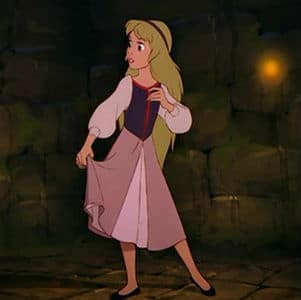
Photo: Disney
When Roy Disney first screened The Black Cauldron, he was reportedly very nervous, mainly because of the darkness of the film. Calling in Jeffrey Katzenberg, the two of them decided that they needed to do some edits, a thing that horrified the animation department.
Morale had been low in the animation department before this, what with all the changes to the department and the way the story itself was progressing (there was a feeling that there wasn’t enough humor to counterbalance the seriousness of the story). The idea of someone who was not part of the animation team weeding out up to 15 minutes of completed footage was another blow.
Despite the problems, Michael Eisner told Bob Thomas that The Black Cauldron was “the most complicated animated movie at its time,” also calling it “beautifully done,” a sentiment that Roy Disney and Jeffrey Katzenberg echo. All three agree, however, that the main problem with The Black Cauldron was the story.
THE PLOT
The plot of The Black Cauldron is the most problematic aspect, for several reasons. First, it is based on a much-loved series of fantasy books by Lloyd Alexander called The Prydain Chronicles, and borrows heavily from the different books while making its own story, sort of. I’ll talk more about that below.
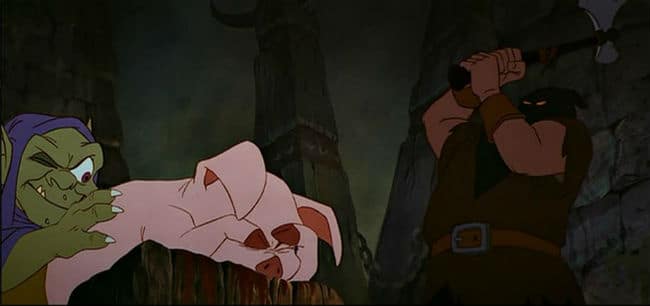
Photo: Disney
Secondly, it’s very dark. The pre-ending makes everyone cry because we all knew even as kids that what happened was not supposed to happen in a Disney movie! By trying to appeal to adults, the Studio learned that there needs to be a balance. The Hunchback of Notre Dame, the other very dark Disney movie, was able to create that balance in a way I found effective (though it was still a scary movie). We’ll talk about that one soon.
The plot of The Black Cauldron, however, goes like this. We open with the omniscient narrator who tells us that once there was a king of Prydain who was so evil that the only way to destroy him was to throw him alive into a giant black cauldron. The cauldron was hidden, because if anyone possessed it they could use its power to raise an army of the undead.
We then cut to a small farm, where a man named Dallben lives with his ward Taran. Taran is in charge of tending for Hen Wen, an adorable pig. However, all he wants to do is go off into the world and fight in the war. Dallben tells him that Hen Wen is very special, and to take good care of her.
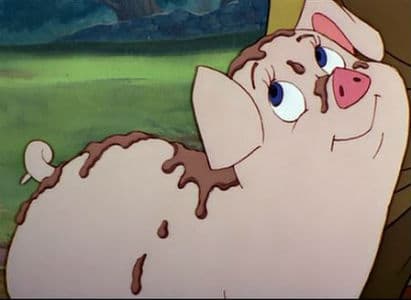
Photo: Disney
Later on, Hen Wen becomes afraid for no apparent reason and as it turns out, she is an oracular pig. When Dallben consults her, he discovers that the evil Horned King is searching for the cauldron, but being unable to find it, he is now hunting for Hen Wen, making the swine seem nervous.
Dallben sends Hen Wen and Taran into the woods to hide until it is safe, but Taran gets lost in a daydream and Hen Wen, being a pig, smells something good and wanders off. When Taran goes to find her, he runs into Gurgi, a small fuzzy thing.
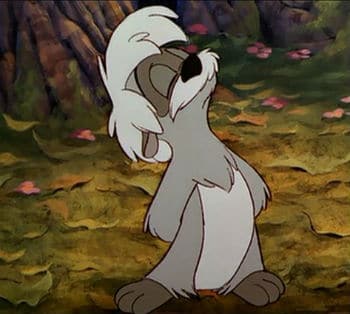
Photo: Disney
Gurgi and Taran get off on the wrong foot when Gurgi, being hungry, steals an apple and lies about having seen Hen Wen in order to get the apple as a reward. He and Taran hear Hen Wen’s cries for help, because she is being chased by the winged servants of the Horned King, and although Taran tries to save her, she is carried off.
Taran feels that he has no choice but to go after her, and while Gurgi tries to talk him out of it, Taran sets off anyway, after calling Gurgi a coward. Taran gets into the castle and proceeds to hunt around, searching for Hen Wen.
After several narrow escapes, he finds her in the throne room, where the Horned King is trying to use her power to find the black cauldron. Without the proper words, however, she is unable and unwilling to show them anything.
When the Horned King’s little green assistant threatens to hurt Hen Wen, Taran falls from his hiding place and is revealed as one of Hen’s people by her excited expression when she sees him unhurt. The Horned King convinces Taran to have Hen Wen show him where the cauldron is by threatening to kill Hen unless she and Taran cooperate.
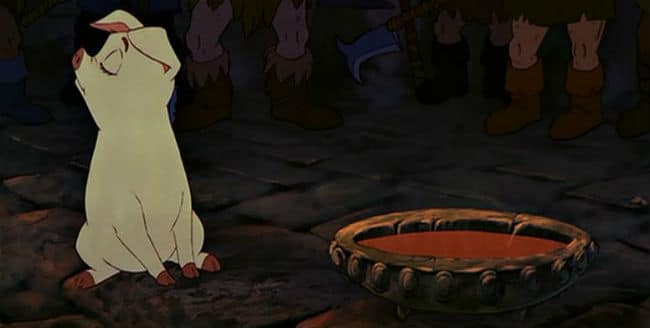
Photo: Disney
When the Horned King sneaks up behind Taran, however, the boy trips and the vision is interrupted. Grabbing Hen, Taran tries to escape. He succeeds in getting Hen out but is captured himself. Locked in the dungeon, he feels that things are hopeless.
Suddenly, a passage opens up and a girl appears. She is a Princess named Eilonwy, and she was captured by the Horn King, who thought her magic bauble could tell her where the black cauldron was. She and Taran head down into the old tunnels to see if they can escape.
They find themselves in the burial chamber of the original owner of the castle and while there, Taran finds a sword. Thinking that it might come in handy later, he takes it with him. He and Eilonwy meet and save Fflewddur, a bard who accidently came to the castle.
As it turns out, Taran now has a magic sword and its powers help them escape. However, the escape scene is a great example of why the film has a PG rating. Although they have escaped, Taran needs to find Hen Wen, and feels like he should go find the black cauldron before the Horned King does, so he can destroy it. When he and his friends run into Gurgi again, the intrepid scamp knows where Hen Wen has gone.
They find her in the care of the Fair Folk, who promise to get her home safely to Dallben. Meanwhile, telling Taran and Company where the black cauldron was last said to be, they send them to the marshes of Morva with Doli, who is to be their guide.
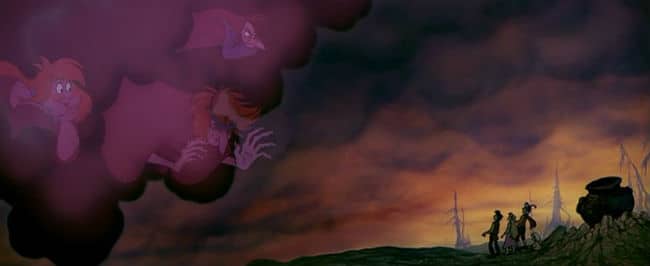
Photo: Disney
In Morva, they encounter the three witch sisters who usually turn trespassers into frogs. After seeing Taran’s sword, however, they agree to a trade, the sword for the cauldron. Taran reluctantly agrees, but when our heroes try to destroy the cauldron, they learn that there is only one way to do so.
If someone climbs into the cauldron, that will destroy it, but kill them in the process. Not sure what to do with that, Taran is afraid that he has failed in his quest. Since they were unaware that they were being followed, the minions of the Horned King capture them and take the cauldron with them. Gurgi panics, however, and runs away.
Tied up above the cauldron chamber, our heroes watch in horror as the Horned King unleashes his army of the undead, the cauldron-born and a great argument for a PG-13 rating.
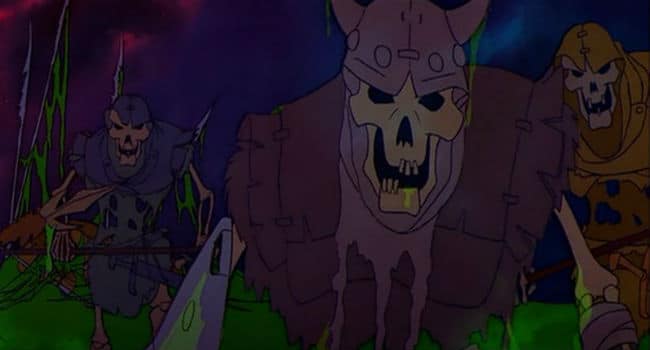
Photo: Disney
Gurgi, meanwhile, sneaks in to save his friends. He unties them, and Taran tells him to help Eilonwy and Fflewddur escape, as he is planning on jumping into the cauldron and sacrificing himself to save the world.
In a moment that makes me cry every time I see it, Gurgi refuses to let his friend die. Jumping in front of Taran, Gurgi plunges into the cauldron before anyone can stop him.
Gurgi’s death stops the cauldron-born in their tracks and they die again. As a result, the Horned King is furious. He attempts to kill Taran, but is sucked into the cauldron in one of the more gruesome Disney villain deaths (I decided to spare you all from a photo of that).

Photo: Disney
With the cauldron destroyed, the castle itself starts to crumble. After many close calls, our heroes are able to escape. They are reminded of the cost of their freedom, however, when they see the cauldron bobbing nearby.
The three witches from Morva try to take the cauldron back, but Taran and Fflewddur insist on making a trade. The witches offer the sword, telling Taran that he could be a real hero with it, but all he wants is his friend Gurgi back.
The witches bring Gurgi back and with that, our heroes head back to Dallben’s house. Dallben, meanwhile, is watching the scene with Hen Wen and Doli and remark on how well Taran did. It’s kind of an abrupt ending.
As a kid, and even as an adult, my big question was and is this: did Gurgi’s un-death mean that the cauldron wasn’t stopped? There were a few other concerns, however. Were other people fighting the Horned King? What was up with the Fair Folk? What was this war Taran talked about in the beginning? (I also wondered why the green minion stayed with the Horned King, but that was less crucial).

Photo: Disney
When I read the books, these questions were answered, but I think that these questions are the reason why the main guys mentioned story as a problem with The Black Cauldron.
SOURCE MATERIAL
Disney had actually gotten the rights to adapt The Prydain Chronicles back in the 1970’s, and like with Beauty and the Beast, the Nine Old Men had tried to adapt it previously.
Written by Lloyd Alexander, The Prydain Chronicles are made up of five books, The Book of Three, The Black Cauldron, The Castle of Llyr, Taran Wanderer and The High King. There is also a tales collection, The Foundling and Other Tales of Prydain.
In the author’s note for The Book of Three, Alexander writes that while his story takes inspiration from Wales and her mythology, The Prydain Chronicles are not really Welsh. Some of the characters are based on Welsh mythology, as is the landscape, but it is a fictional fantasy land.
There are characters missing from the Disney film, mainly Archen, Coll, and Gwydion. The main villain of the series is Arawn, who does not appear in the film. The person who dives into the cauldron was not Gurgi in the books, which answers an important plot question I always had. Also, the Fair Folk can’t just turn invisible, that was a wish of Doli’s. I’ve read these many times, can you tell?
The Horned King is not after the cauldron, Arawn is. The Horned King is a terrifying villain after Hen Wen, but that occurs in the first book while the cauldron was the focus of the second book. The castle sinking into the waves occurs in book three, The Castle of Llyr. Also, in the books, the three sisters are not villains, they’re closer to the Three Fates, or the Mother, Maiden, Crone mythology; they’re powerful but they don’t interfere.
Available on Amazon or in most bookstores, if you’re a fan of fantasy, you will probably love this series. They’re not long books, but they are full of fun characters, high stakes, and wonderful stories. It’s a sprawling fantasy epic that has captivated the imagination of readers for years since The Book of Three was published in 1964. I read somewhere that Disney still has the film rights, maybe the time has come for a five-film series?
The 1980’s
So, in the 1980’s, like I said last week, many Americans began to look for a more conservative approach in politics, social life, and the economy. The popular culture of the 1980’s can be seen as a direct result of this conservative approach.
The History Channel mentions the “yuppie” and calls that person the “symbol of the decade.” A yuppie was a baby boomer with a college education, a well-paying job and expensive tastes. Basically, the ideal person was very concerned with making money and purchasing stuff more than previous generations.
Some called the yuppies shallow, but the ’80’s, from what I’ve read, seems a time of great contrast. On the one hand, people were doing what is supposed to make them happy, but are they? Many, historians say, they were not, because money can’t buy happiness.
Meanwhile, the History Channel says the ’80’s were the “age of the blockbuster,” larger than life movies that covered a range of topics. By the end of the decade, a majority of Americans had cable, and cable included MTV.
MTV was debuted on August 1st, 1981, and played music videos (apparently that’s not the case anymore). The History Channel says that MTV made stars out of Duran Duran and other artists while some artists were catapulted into mega-stardom. The example we are given for this is Michael Jackson.
When Michael Jackson’s “Thriller” video aired on MTV, 600,000 albums sold in the first week. My mom told me once that, before the “Thriller” video began to play on MTV there was a disclaimer that neither MTV nor Michael Jackson supported the occult and that the following video was for entertainment purposes only. That, she said, was how they all knew that “Thriller” was coming up.
Into this climate, The Black Cauldron makes sense. It fits in with the other movies of the 80’s and has a tie-in with popular ’80’s music videos, particularly “Thriller,” even though it is not what we expect from our Disney films.
LESSONS LEARNED
Well, I suppose one lesson learned is from the history of the film. Animation is special in that it allows us to all connect to our inner child, so even films that are dark and more frightening should still be accessible to that demographic.
Secondly, there is no greater love than dying for your friends (and a world of people you don’t know). Gurgi makes the ultimate sacrifice when he jumps into the cauldron, and he does it to save his friends.
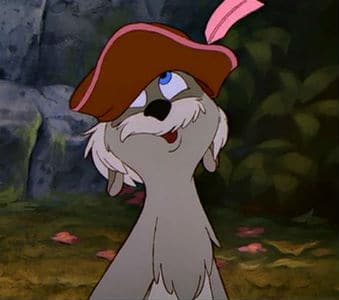
Photo: Disney
Thirdly, don’t let your imagination run away with you. When Taran is supposed to be keeping Hen Wen safe, he gets caught up in daydreams and Hen Wen wanders off. It’s that inattention to reality that allows Hen to be caught by the Horned King.
Finally, bravery is different for everyone. Taran, Gurgi, Eilonwy, Hen Wen, and Fflewddur all are afraid at different times throughout the film, and they all face their fears in different ways. All of them are brave, but what was brave for Fflewddur might not be being brave for Eilonwy, and so on.
DOES IT HOLD UP?
The Black Cauldron is an interesting movie in that it was technologically very advanced, beautifully animated, has a beautiful score, and was based on a beloved series of books, but it is also very dark and scary, as well as annoying to fans of the books for playing mix-and-match with a wonderful series.
Regardless, it has become a bit of a cult classic and, even though it can be quite scary at times, it’s well worth a watch. Honestly, I love the books, but this is still one of my favorite Disney films. Think of it more as an homage and less of an adaptation.
FUN FACT: John Hurt, who has been in so many wonderful things, voiced the Horned King. Seriously, everything I haven’t seen yet is on my to-watch list. He’s also in The Gruffalo, which leads me to wonder, when did that become a film?!
For next week: The Great Mouse Detective
If you enjoyed this post and the others in the Revisiting Disney series, and have found yourself wishing that you could find them all in one convenient and bound book with eight extra essays, there is an option for you! Check out A Journey Through Disney: My Look Back Through Disney Canon, now available on Amazon as both a Kindle book ($4.99) and a paperback ($11.99).
OTHER SOURCES:
https://thewaltdisneycompany.com/about-disney/disney-history
http://www.imdb.com
http://studioservices.go.com/disneystudios/history.html
http://www.history.com/topics/1980s
Bailey, Adrian. Walt Disney’s World of Fantasy. Everest House Publishers. New York, New York. 1982.
Finch, Christopher. The Art of Walt Disney: From Mickey Mouse to the Magic Kingdom. Harry N. Abrams, Inc. New York, New York. 1975.
Sale, Roger. Fairy Tales and After: From Snow White to E.B. White. Harvard University Press. Cambridge, MA, 1978.
Tatar, Maria. The Annotated Classic Fairy Tales. W.W. Norton and Company. New York and London, 2002.
Thomas, Bob. Disney’s Art of Animation From Mickey Mouse to Hercules. Hyperion. New York, New York. 1992.
Wright, Gordon. The Ordeal of Total War: 1939-1945. Harper Torchbooks, Harper & Row. New York, Hagerstown, San Francisco, and London, 1968.
ARE YOU A ROMANCE FAN? FOLLOW THE SILVER PETTICOAT REVIEW:
 Our romance-themed entertainment site is on a mission to help you find the best period dramas, romance movies, TV shows, and books. Other topics include Jane Austen, Classic Hollywood, TV Couples, Fairy Tales, Romantic Living, Romanticism, and more. We’re damsels not in distress fighting for the all-new optimistic Romantic Revolution. Join us and subscribe. For more information, see our About, Old-Fashioned Romance 101, Modern Romanticism 101, and Romantic Living 101.
Our romance-themed entertainment site is on a mission to help you find the best period dramas, romance movies, TV shows, and books. Other topics include Jane Austen, Classic Hollywood, TV Couples, Fairy Tales, Romantic Living, Romanticism, and more. We’re damsels not in distress fighting for the all-new optimistic Romantic Revolution. Join us and subscribe. For more information, see our About, Old-Fashioned Romance 101, Modern Romanticism 101, and Romantic Living 101.

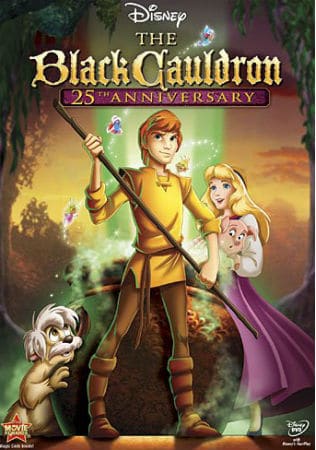
Comments are closed.